Canon Pocketronic, Pocketronic II,
& Monroe 10
Three very early hand-held calculators from the same stable, with output printed on thermal paper tape.
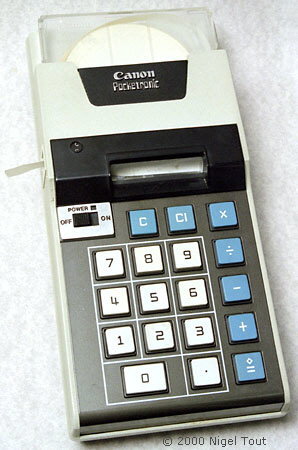
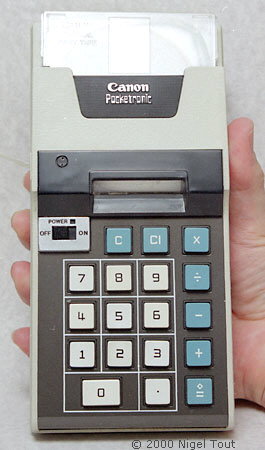
Canon Pocketronic
Distinctive features: One of the first hand-held, battery-powered calculators. No display, calculations are printed on thermal paper tape.
Technical details:
Display is by printout on thermal paper tape.
Four-function.
Main integrated circuits - Texas Instruments TMC1730B, TMC1731A, & TMC1732A (here date coded weeks 18 and 19 of 1971) MOS (Metal Oxide Semiconductor) integrated circuits[2].
15.6v (13x NiCd rechargeable cells).
100 mm x 208 mm x 48 mm (4" x 8.2" x 1.9").
Launched in Japan in October 1970[1], and the USA in early 1971[2].
Made in Japan.
Texas Instruments started to investigate the design of a hand-held calculator in 1966 with the "Caltech" project. This calculator was the resulting commercial product, manufactured by Canon. Texas Instruments was awarded U.S. and Japanese patents for a "Miniature Electronic Calculator".
At this date there was little choice for the display technology of such a small hand-held calculator:
- "Nixie"-type tubes, common in the contemporary desktop calculators, were large and power hungry.
- Vacuum fluorescent displays (VFDs) were a very recent Japanese development, pioneered by Sharp which had just used them in its EL-8, and were also quite large
- No calculator had yet used the new light-emitting diode (LED) displays which were then very expensive.
- Liquid crystal displays (LCDs) were still in development.
So, like the prototype Texas Instruments Caltech, the output is printed on thermal paper tape, which was manufactured by 3M[2]. The print head is a 20-segment array where the appropriate segments are heated to 400°F (200C) in 1/100 sec. to produce the required digit on the thermal paper[4]. "The developers are aiming the under-$400 unit at the home and small office market"[5].
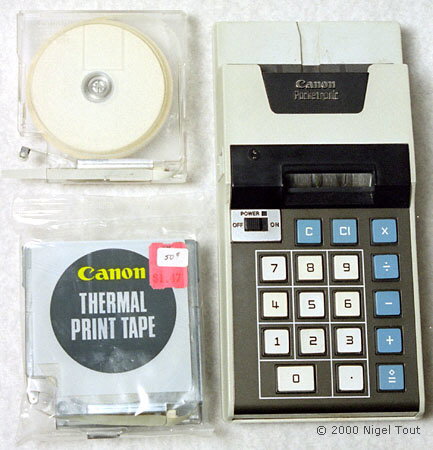
Calculator with the thermal tape cartridge removed and a new, sealed cartridge.
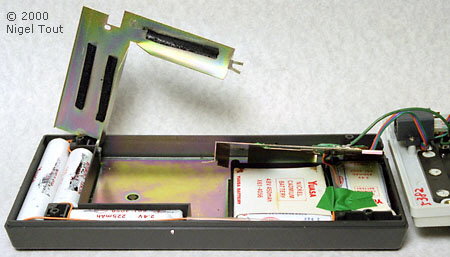
The base of the calculator with covers opened showing the 13 rechargeable cells which are squeezed in.
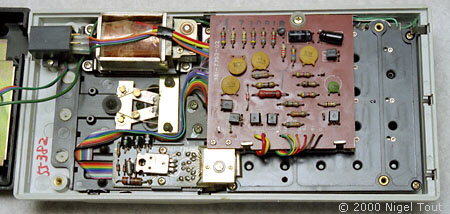
Beneath the keyboard showing the printing mechanism and electronics.
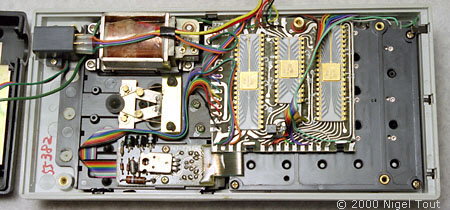
Beneath the keyboard with the printer circuit board removed to reveal the 3 calculating integrated circuits.
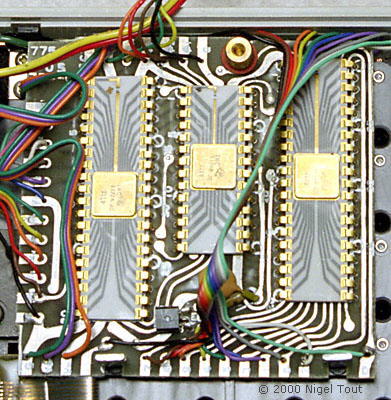
Close up of the Texas Instruments TMC1730B, TMC1731A, & TMC1732A integrated circuits, in ceramic packages.
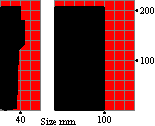
Significance:
The Canon Pocketronic was among the first hand-held calculators.
Although it is hand-holdable it is not really a "pocket" calculator due to its great length and thickness (208 mm / 8.2" by 48 mm / 1.9").
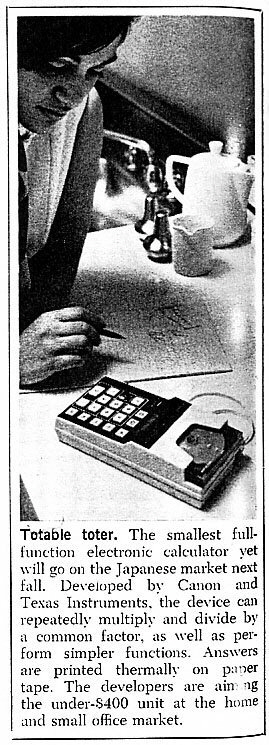
The journal 'Electronics' reported in April 1970[2]:
"Japan's Canon Inc. and Texas Instruments have built a calculator that fits into a slim case not
much larger than a paperback book. Called the Pocketronic, the mini-calculator adds, subtracts, multiplies, and divides: it can also perform repeated multiplications and divisions with a common factor, and its results
appear as hard copy printed on a strip of paper. Canon and TI designed the machine around three MOS circuits that contain almost all the machine's circuitry. Not included in the three chips are the system clock,
the paper advance controls, the printing mechanism and the 10-key keyboard. The printing mechanism is based on the thermal printer TI introduced last year and the paper tape is made by 3M Corp. comes in a
cassette. Marketing of the calculator will start in Japan next fall and in the U.S. early in 1971. Price under $400."
The journal 'Electronic Design' reported in May 1970[3]:
"The calculator will be available for sale in Japan later this
year, and in the U.S. in January 1971. Initially, prices are expected to be under $400, with production starting at 10,000 units per month. Eventually, it is rumored, the price may drop to $100.
...
All
calculations are performed by three LSI chips built by TI. Total logic complexity for the three chips is 371 gates (with an average of 4.2 inputs per gate), 203 shift register bits, and 10 flip-flops."
Left - Report in May 1970 of the Canon Pocketronic due to be launched in Japan in the fall of that year.
It is notable that at this point in the development of calculator electronics that three large-scale integrated circuits (LSI) were required for the calculating functions.
The magazine Electronics Australia gave a good summary of the calculator's capabilities[6]:
" Simple calculations such as addition, subtraction,
multiplication, division and raising a number to a power are all performed easily. For addition the unit will give running totals and then carry on with further additions. Mixed calculations such as addition followed by
multiplication may also be carried out. However since the unit has no memory chain multiplications must be carried out in separate steps.
Digit capacity is twelve operational digits both for calculation and
result printout, with 8 digits to the left of the decimal point and four digits after. Negative results are indicated with a negative sign. In operation, all entries are read out on tape as the appropriate buttons
buttons are pressed. If the number of digits exceeds the capacity of the unit, it locks and prints out E for an overflowed entry and C for an overflowed result.
The thermal printout tape is supplied in plug-in
cassettes packed with approximately 260 feet of tape, which is sufficient for up to 3000 calculations. Since the tape is heat sensitive it must be stored in a cool place. The operating temperature range is 0 C to 40 C
(32 F to 104 F) so that it could not be used in some parts of Australia.
The internal batteries of the Canon Pocketronic allow up to 3 hours continuous operation when fully charged. In addition, when connected
to the Canon 20A battery charger, it may be used with flat batteries after about 5 minutes wait. The battery charger takes about 3 hours to completely charge a flat battery and it may be left connected indefinitely as it has
overcharge limiting. An indicator on the charger tells when charging is complete. ...
A smaller capacity battery charger, the model 10A, is also available. It takes 14 hours to completely charge the
batteries and does not have overcharge limiting. Nor will it allow the Pocketronic to be used with flat batteries as will the model 20A."
When introduced in 1970 these calculators were at the cutting edge of technology and still having teething troubles. This is illustrated by a news story in the magazine Electronics in January 1971[7]:
"TI production woes delay calculator
Canon's pocket calculator, which was to be selling in the U.S. last
month, is being delayed because production of its thermal print head by Texas Instruments is two months behind schedule. The calculator, called Pocketronic is designed around three MOS circuits and can add, subtract,
multiply, and divide; it was to sell for less than $400.
TI's James W. Clifton, manager of display products, says he expects to catch up during the second quarter. The print head, which is used with
thermally sensitive paper to provide hard copy readout, is a silicon array of small dots that can be heated in various combinations to form numbers and other characters. Clifton attributes the delay to the fast turnaround
time initially scheduled for the project: 15 months from laboratory to the large-scale production required by the Japanese firm. The Canon calculator also uses three of TI's MOS/LSI circuits. Apparently, there is no problem
in delivering these circuits."
A year or two later Texas Instruments started producing its own range of calculators and sold calculator ICs to many other manufacturers.
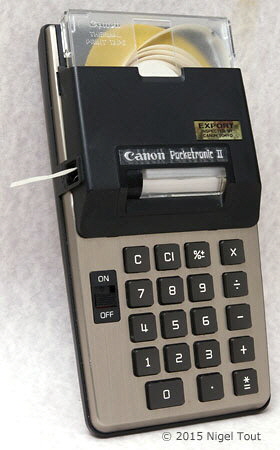
Canon Pocketronic II
Distinctive features: An updated version of the Canon Pocketronic with more integrated electronics, though no smaller and still heavy. No display, printout on thermal paper tape.
Styling resembles the Monroe 10, below, rather than the original Pocketronic, above.
Technical details:
Display is by printout on thermal paper tape.
Four-function, %.
Main integrated circuits - Texas Instruments TMC0138NC & TMS0641NC (here both are date coded week 29 of 1974).
15v (rechargeable battery pack).
100 mm x 200 mm x 48 mm (4" x 8.2" x 1.9").
Made in Japan.
This calculator is large, heavy, and with output only on the special thermal paper is a bit old-fashioned for the mid- to late-1974 date of when it would have been made, judging by the date codes on the ics.
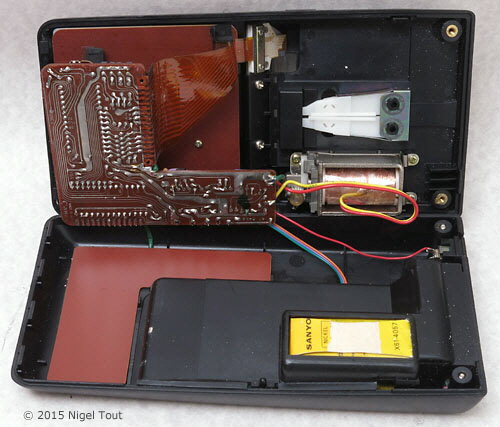
Inside the Canon Pocketronic II, showing that the higher level of integration of the electronics requires only a single small circuit board.
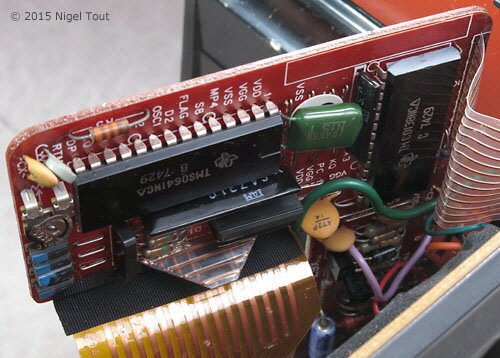
Close up of the circuit board showing the two Texas Instruments integrated circuits: TMC0138NC & TMS0641NC.
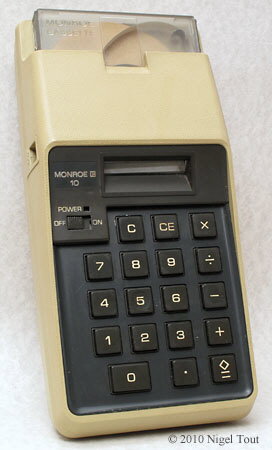
Monroe 10, aka "Shrimp"
Distinctive features: Restyled Pocketronic, with styling resemblance to the Pocketronic II, which it preceded. Labelled by Canon for Monroe, a well-established U.S.A. calculator manufacturer and marketing company.
Technical details:
Main integrated circuits - Texas Instruments TMC1730, TMC1731, & TMC1732 (here date coded weeks 41 and 43 of 1970).
103 x 219 x 43 mm (4.1" x 8.6" x 1.7").
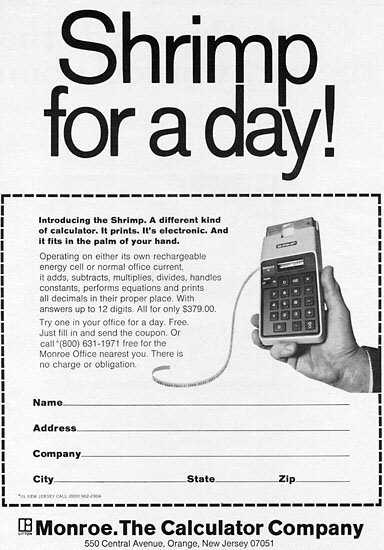
Advertisement from 1971 for the Monroe 10, here called the "Shrimp".
The cost was "only" US$379.00 (about GBP £160).
According to the U.S. Inflation Calculator the equivalent cost in 2014 would be about US$2,200!
References
- Dentaku Museum site at http://www.dentaku-museum.com/.
- "Pocket model", Electronics, Apr. 27 1970.
- "Canon and TI develop LSI pocket calculator", Electronic Design, May 24, 1970, p22
- "Carry This Calculator in Your Pocket", Popular Science, August 1970, p59.
- "Totable toter", Electronics, May 11, 1970, p12E.
- "Canon Pocketronic Calculator", Electronics Australia, January 1972, p101.
- "TI production woes delay calculator", Electronics, Jan. 4 1971, p17.
Hand-held Calculators
Vintage Calculators
Text & photographs copyright, except where stated otherwise, © Nigel Tout 2000-2026.